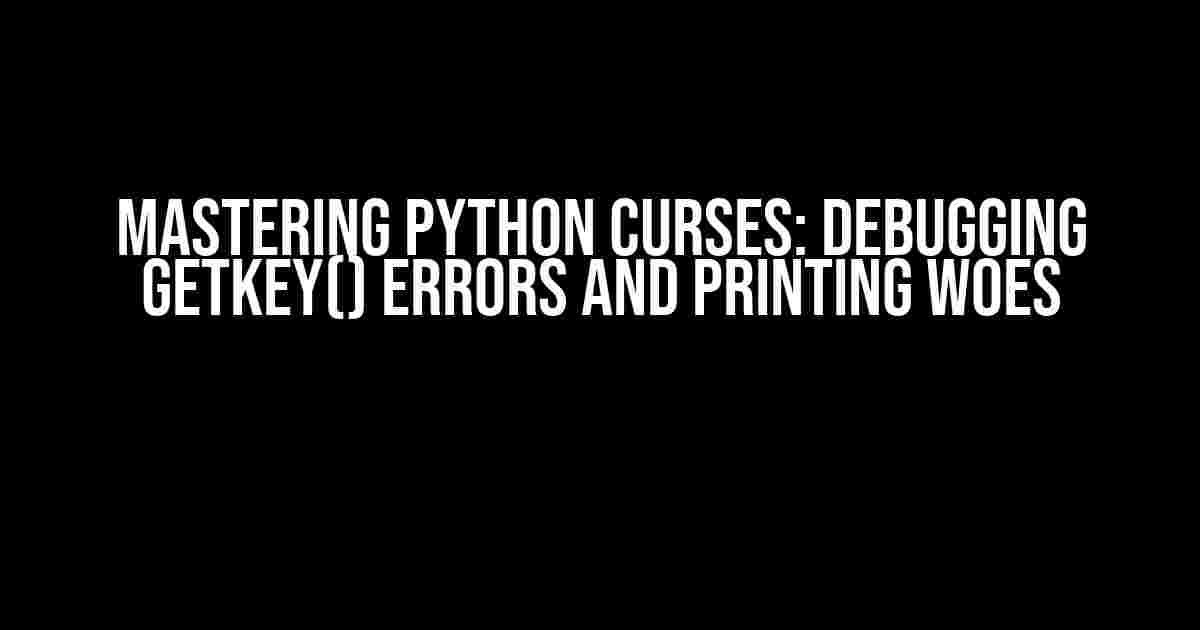Are you tired of wrestling with Python Curses, only to be left with a mess of getkey() errors and printing nightmares? Fear not, dear developer, for this comprehensive guide is here to illuminate the path to Curses mastery. By the end of this article, you’ll be well-equipped to tackle the most stubborn getkey() conundrums and printing pitfalls, and emerge victorious with a solid understanding of Python Curses.
The Curses Conundrum: Understanding getkey()
Before diving into the thick of it, let’s take a step back and examine the getkey() function, the root of many Curses-related woes. getkey() is a fundamental method in the Curses library, responsible for retrieving user input from the terminal. It’s deceptively simple, yet prone to mysterious errors and quirks.
getkey() Syntax and Usage
win.getkey([y, x])The getkey() method takes an optional pair of coordinates (y, x) as arguments, specifying the window and position from which to retrieve the user’s input. If no coordinates are provided, getkey() defaults to the current cursor position.
Common getkey() Errors and Their Solutions
Now that we’ve covered the basics, let’s tackle some common getkey() errors and their solutions:
| Error | Solution |
|---|---|
Error: getkey() returns None |
Ensure that the window is properly initialized and the curses.initscr() function has been called. |
TypeError: getkey() takes no arguments |
Remove the coordinates from the getkey() call, as they are optional. |
AttributeError: 'WindowObject' object has no attribute 'getkey' |
Verify that the window object has been correctly created and is a valid instance of the WindowObject class. |
Printing in Curses: Overcoming the Challenges
Printing in Curses can be a daunting task, especially when working with complex layouts and window hierarchies. Let’s delve into some common printing pitfalls and their solutions:
The Addstr() Method: A Primer
win.addstr(y, x, str)The addstr() method is used to print a string to the specified window at the given coordinates (y, x). It’s a fundamental building block for printing in Curses.
Common Printing Errors and Their Solutions
Here are some common printing errors and their solutions:
-
Error: Printing outside of window boundaries- Solution: Verify that the coordinates (y, x) are within the window’s boundaries.
-
Error: Printing over existing content- Solution: Use the win.clear() method to clear the window before printing.
-
Error: Printing with incorrect attributes- Solution: Use the win.attrset() method to set the correct attributes (e.g., colors, styles) before printing.
Best Practices for Working with getkey() and Printing in Curses
To ensure smooth sailing in your Curses development journey, follow these best practices:
-
Initialize the Curses environment correctly, using curses.initscr() and curses.noecho() to disable echoing and enable keyboard input.
-
Use the getkey() method judiciously, ensuring that the window is properly initialized and the coordinates are correct.
-
Clear the window before printing to avoid overwriting existing content.
-
Use the correct attributes when printing, such as colors and styles, to ensure consistency and readability.
-
Test your code thoroughly, using debugging tools and techniques to identify and resolve issues.
Putting it all Together: A Sample Curses Application
import curses
def main(stdscr):
stdscr.clear()
stdscr.attrset(curses.A_BOLD)
stdscr.addstr(0, 0, "Python Curses Demo")
stdscr.addstr(1, 0, "Press any key to exit...")
stdscr.refresh()
stdscr.getkey()
stdscr.clear()
stdscr.addstr(0, 0, "Goodbye, Curses!")
stdscr.refresh()
curses.napms(1000)
curses.wrapper(main)
This simple demo showcases the basics of Curses programming, including window initialization, printing, and user input handling. Note the use of the getkey() method to retrieve the user’s input and the clear() method to refresh the window.
Conclusion
With this comprehensive guide, you’ve taken a significant step towards mastering Python Curses and overcoming the common hurdles associated with getkey() errors and printing woes. By following best practices, understanding the intricacies of getkey() and printing, and testing your code thoroughly, you’ll be well-equipped to tackle even the most complex Curses projects.
Remember, practice makes perfect, so don’t be afraid to experiment and try new things. Happy coding, and may the Curses be with you!
Frequently Asked Question
Get ready to squash those pesky `getkey()` errors in Python’s curses module! Here are the top 5 questions and answers to get you back on track:
Why do I get a `getkey()` error when I run my Python curses program?
Ah, rookie mistake! Make sure you’ve initialized the curses module by calling `curses.initscr()` before calling `getkey()`. This sets up the terminal for curses mode, and voilà! No more `getkey()` errors.
I’m getting a `getkey()` error when I try to capture keyboard input in my curses program. What’s going on?
Hmm, sounds like you might be trying to call `getkey()` without putting the terminal in cbreak mode. You need to call `curses.cbreak()` before calling `getkey()` to enable character-by-character input. Problem solved!
Why does my curses program crash when I press a key and it calls `getkey()`?
Oops, sounds like you forgot to handle the keypad input! When you call `getkey()`, you need to make sure the keypad is enabled by calling `stdscr.keypad(True)`. This lets curses handle the keypad input correctly, and your program won’t crash anymore!
Can I use `getkey()` to capture mouse events in my curses program?
Sorry, buddy! `getkey()` is only for keyboard input. If you want to capture mouse events, you need to use `curses.getmouse()`. Make sure to call `curses.mousemask(1)` to enable mouse events, and then you can use `getmouse()` to get the mouse coordinates and event type!
How do I handle `getkey()` errors when the user presses a key that’s not supported by my curses program?
Nice catch! When you call `getkey()`, you can use a `try`-`except` block to catch `curses.error` exceptions, which are raised when the user presses an unsupported key. Just handle the error by ignoring the key press or displaying an error message, and your program will keep on truckin’!
